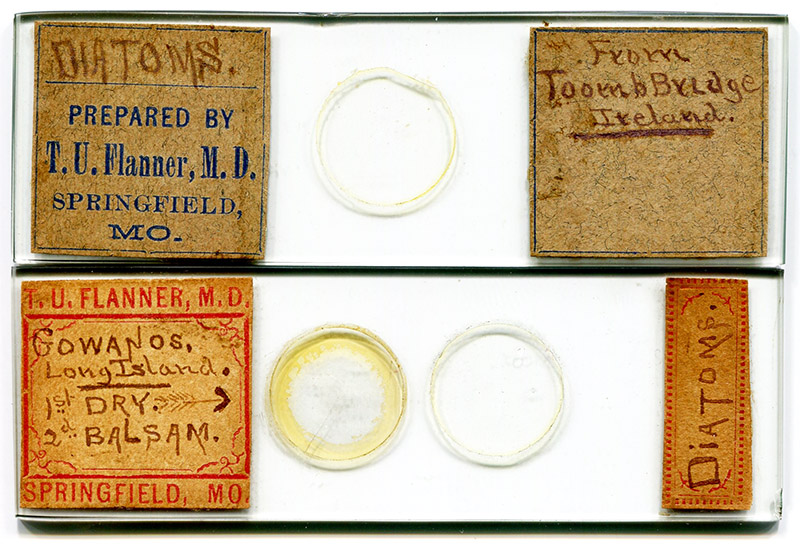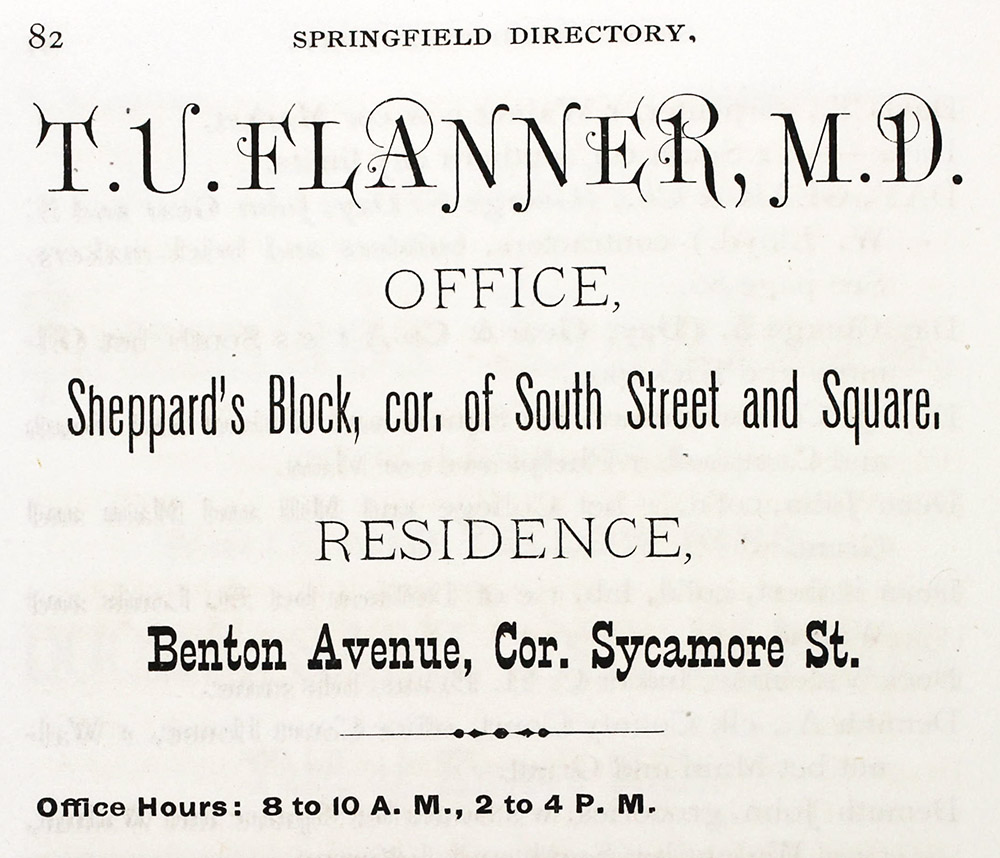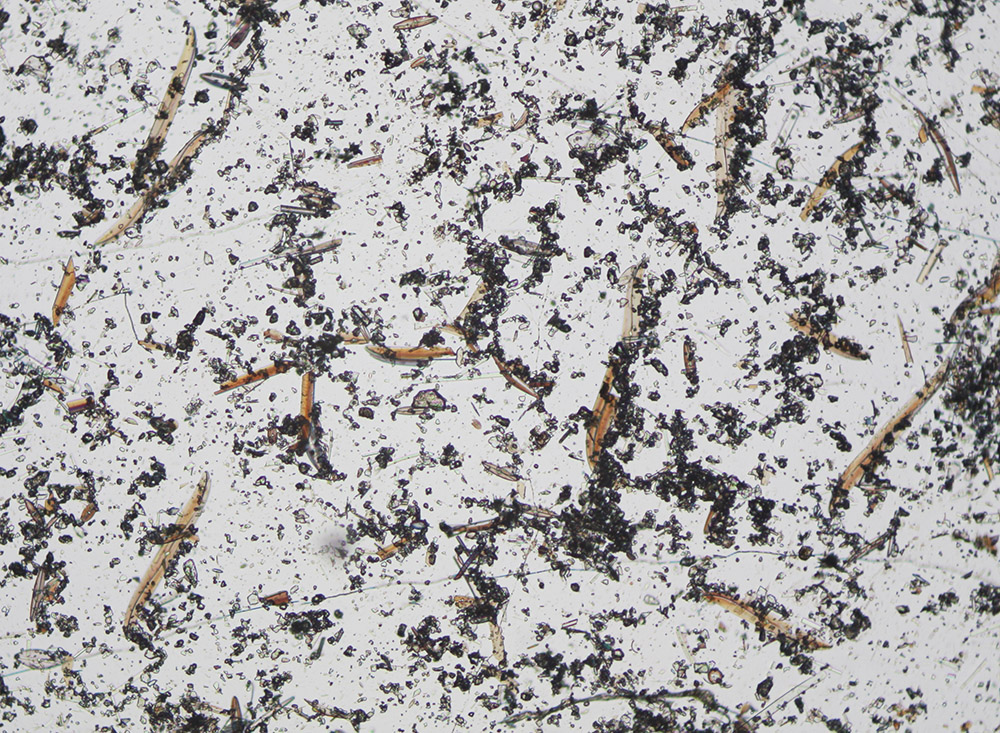
Figure 1. Microscope slides by Thomas U. Flanner, probably made during the mid-1870s.
Thomas Updegraff Flanner, 1830 - 1884
by Brian Stevenson
last updated January, 2023
T.U. Flanner was an American physician and surgeon. During the 1870s, while living in Springfield, Missouri, Flanner produced microscope slides with custom-printed labels, for exchange with other microscope enthusiasts. He appears to have been primarily interested in diatoms (Figures 1 and 2).

Figure 1.
Microscope slides by Thomas U. Flanner, probably made during the mid-1870s.

Figure 2.
Flanner advertised to exchange unfinished diatomaceous material or prepared slides during 1876 and 1877. Prior to moving to Springfield, Missouri, Flanner had lived in Quincy Township in the Upper Peninsula of Michigan, next to Lake Superior. From “The American Journal of Microscopy and Popular Science” (top) and “The American Naturalist” (bottom).
Thomas Updegraff Flanner was born on January 5, 1830, in Mount Pleasant, Ohio. His middle name was the maiden name of his mother, Mary. Father William Flanner was a medical doctor. Thomas was the eldest of three children.
Thomas attended medical school at the University of Pennsylvania, graduating in 1851. He wrote his graduation essay on tuberculosis.
After practicing medicine in Ohio for a year, Flanner became staff physician and surgeon for the Minnesota Copper Mine, in Rockland Township, in the Michigan Upper Peninsula. A history of the Upper Peninsula stated, “Dr. Flanner was one of the very earliest of the pioneer physicians of Lake Superior, and stands deservedly high in his profession.”
He somehow met Augusta S. Waite, and married her on May 27, 1856 at her parent’s hometown of West Randolph, Vermont. They eventually had 5 children, of whom only 2 survived childhood.
After the wedding, the Flanners returned to Thomas’ medical practice in Michigan. In 1866, he moved to the nearby Quincy Mine, with a report from the Board of Directors stating, “The health of our people has been remarkably good … the medical department has been placed in charge of Doctor T.U. Flanner, whose reputation as a surgeon and physician needs no endorsement from me.”
Evidently a civically-minded man, Thomas helped found the Houghton County Historical Society and Mining Institute in 1865. He was the group’s first Corresponding Secretary.
Shortly after the 1870 census was taken, the Flanner family moved to Springfield, Missouri, where Thomas began a private practice. Thomas’ widowed mother, who had been living with them, died in Springfield in 1871.
In 1872, Thomas and two colleagues founded the Gate of Temple Masonic Lodge in Springfield. He served on the City Council in 1873 and 1874. In 1876, Flanner was on the Board of Directors of the Springfield Cotton Mill. He was a Trustee and member of the Executive Committee of the Missouri Conservatory of Music and Reading, at nearby Drury College.
During 1876 and 1877, Flanner issued numerous requests to exchange microscopical slides and unmounted material, in The American Journal of Microscopy and Popular Science and "i>The American Naturalist (Figure 2). I have not learned whether he was a member of a local microscopical society. However, he evidently had a continued interest in the microscope, as he taught a course on the topic at the 1880 Drury College “Summer School of Biology”.
The Flanners moved back to Quincy Township, Michigan in July, 1881, with Thomas re-assuming his position as physician and surgeon of the Quincy Mine. Thomas died there, on January 17, 1884. His widow, Augusta, moved back to Springfield to live with her married daughter and family.
In addition to his interest in microscopy, Flanner was a student of geology. His mineral collection was donated to Drury College, described as “In Mineralogy there are about three thousand specimens of the principal ores and minerals of the country, and those of Missouri are especially well represented. This collection includes the unique and valuable cabinet of the Lake Superior copper ores made by the late Dr. T.U. Flanner, for many years surgeon of the Minnesota and Quincy mines.”

Figure 3.
An 1873 advertisement, from "The Springfield City Directory".

Figure 4.
Diatoms from Toome Bridge, Ireland, mounted ca. 1877 by T.U. Flanner (see Figure 1). He presumably acquired the diatom gathering through an exchange, mounted a sample, then traded it with a third microscopist. This slide was acquired from California as part of a collection of American-made slides. Photographed with a 3.5x objective lens and C-mounted digital SLR camera on a Leitz Ortholux II microscope.
Resources
The American Journal of the Medical Sciences (1851) Graduates of the University of Pennsylvania, April, 1851, pages 284-285
American Journal of Microscopy and Popular Science (1876) Exchange offers from T.U. Flanner, Vol. 1, page 52 and others
American Journal of Microscopy and Popular Science (1877) Exchange offers from T.U. Flanner, Vol. 2, page 16 and others
The American Naturalist (1877) Exchange offer from T.U. Flanner, Vol. 11, page 573
Annual Catalogue of Drury College at Springfield, Greene County, Mo (1877) page 40
The Boston Medical and Surgical Journal (1856) Married, page 367
Catalogue of the Alumni of the Medical Department of the University of Pennsylvania, 1765-1877 (1877) Society of the Alumni of the Medical Department, page 59
Escott, G.S. (1876) Gate of Temple Lodge, History and Directory of Springfield and North Springfield, pages 139 and 157
Flanner, T.U. (1880) The State’s best citizen – the Doctor, Medical Rhymes, ed. By Hugo Erichsen, pages 75-77
History of Greene County, Missouri (1883) Masonic Lodge, page 848
History of the Upper Peninsula of Michigan (1883) Western Historical Company, Chicago, pages 274-275 and 318
Missouri Weekly Patriot (1876) The Cotton Mill, issue of May 11, accessed through https://thelibrary.org/blogs/article.cfm?aid=3810
Popular Science Monthly (1880) Note on the Summer School of Biology at Drury College, page 280
Springfield City Directory (1873) pages 82 and 93
US census and other records, accessed through ancestry.com